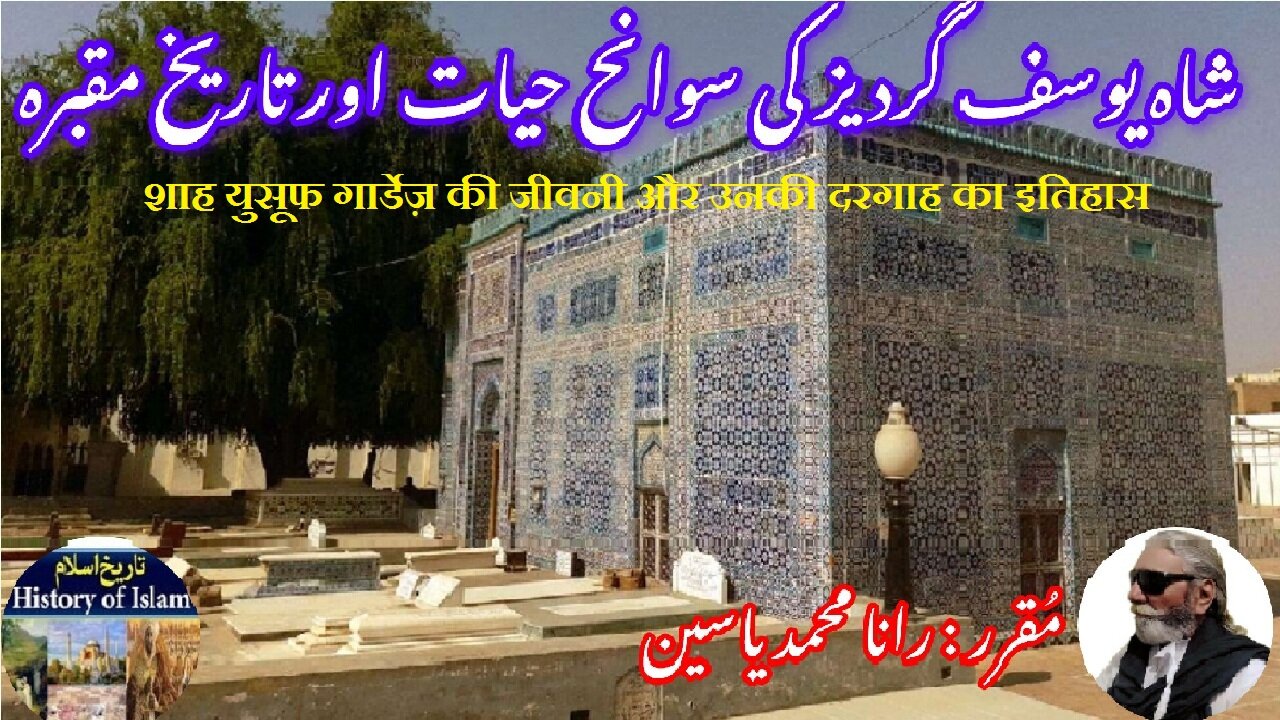Premium Only Content

Shah Yusuf Gardez and his shrine शाह यूसुफ गार्डेज़ شاہ یوسف گردیز کی سوانح حیات اور مزار کی تاریخ
@islamichistory813 #shah #yousuf #gardez #sufisaint #cultural #heritage #biography #islamic #mysticism #islamic #philosophy #shrine #historical #figures #Burial #places #biography #islamic #political #leaders #islamic #scholar
Biography of Shah Yousuf Gardez and the history of his shrine
Dekhti Aankhooon aur sountay kaanoon ko Asslamoalaikum, sisters, brothers friends and elders, in informative series videos of Islamic ascolars, sufisaints, cultural heritages, islamic philosophys, islamic mysticisms and historical figures. today we are describing biography of Shah Yousuf Gardez and the history of his shrine.
Shah Yousuf Gardez, an eminent Islamic scholar and Sufi saint, is one of the most revered figures in the spiritual history of Multan, Pakistan. Born in Gardez, located in present-day Paktia Province of Afghanistan, Shah Yousuf Gardez hailed from a noble and spiritually inclined family. He is believed to have arrived in Multan in 1088 AD during a time of great political and religious turmoil. The city had faced a period of decline due to invasions and internal conflicts, and Shah Yousuf Gardez played a crucial role in its spiritual and civic restoration. His arrival marked the beginning of a new era for Multan, often referred to as the "City of Saints." With his profound spiritual knowledge, charisma, and dedication to the Islamic cause, he contributed significantly to the spread of Islam, particularly Twelver Shia Islam, in the region. His presence brought peace and spiritual revival to the area, and he is credited with converting a large number of people to Islam and performing numerous miracles that further increased his influence and following.
Shah Yousuf Gardez is remembered not just for his religious propagation, but also for his efforts to establish a just and harmonious society. He preached values of unity, humility, and divine love, and became a beacon of guidance for both the rulers and common people of Multan. His teachings, deeply rooted in Islamic principles and Sufi philosophy, inspired generations and laid the foundation for the strong Sufi traditions that later flourished in the region. His spiritual legacy became especially significant in the context of Twelver Shia Islam, as he was among the early figures who brought the teachings of the Twelve Imams to the Indian subcontinent, fostering a deeper understanding of Islamic theology and ethics.
Shah Yousuf Gardez passed away in the 12th century, though the exact date of his death is not clearly recorded in historical sources. Despite this uncertainty, his influence remained enduring, and after his death, his followers and admirers constructed a shrine in his honor to commemorate his contributions and provide a space for spiritual reflection. His tomb is located in the historic city of Multan, in the present-day province of Punjab, Pakistan. It is situated near the Bohar Gate area, close to the old city, and stands as one of the oldest and most prominent shrines in Multan. Over the centuries, this sacred site has become a major pilgrimage center, drawing thousands of devotees, travelers, and seekers of spiritual knowledge.
The shrine of Shah Yousuf Gardez is notable not only for its religious significance but also for its unique architectural style. Built in the traditional Islamic and pre-Mughal architectural design, the structure is adorned with striking blue glazed tiles, intricate brickwork, and beautiful geometric patterns that are distinctive to Multan’s ancient spiritual architecture. The original shrine was constructed shortly after his death by his close followers and spiritual descendants. Over time, it underwent several renovations and enhancements, particularly during the Mughal era and later under the patronage of local rulers who recognized the importance of preserving the heritage of such a revered saint. The shrine’s distinct blue tile work became a stylistic influence for many later Sufi shrines in South Asia.
Throughout the centuries, various caretakers known as *sajjada nashins* (hereditary custodians) have maintained the shrine, overseeing not only the physical upkeep but also the continuation of religious traditions, festivals, and rituals associated with Shah Yousuf Gardez. The annual *urs* (death anniversary celebration) held at the shrine attracts pilgrims from all over Pakistan and even abroad. The event is marked by the recitation of devotional poetry, *qawwali* music, communal prayers, and acts of charity, all done in memory of the saint’s life and teachings. It serves as both a spiritual gathering and a cultural festival that reflects the deep-rooted connection between the people of Multan and their Sufi heritage.
Shah Yousuf Gardez’s shrine stands today not only as a tomb but as a living center of spiritual activity and intercommunal harmony. It symbolizes the profound impact one individual can have on the religious and cultural fabric of a society. His efforts to restore Multan, spiritually and socially, earned him immense respect, and his teachings continue to inspire those seeking inner peace and divine connection. For over nine centuries, the legacy of Shah Yousuf Gardez has remained embedded in the soul of Multan, and his shrine continues to shine as a beacon of Sufi wisdom, drawing all who seek truth, love, and spiritual awakening.
With this, we seek your permission until tomorrow, tomorrow we will describe the biography of Shah Hussain and the history of his Shrine.
Allah Hafiz
==============================
-
 6:06
6:06
ISLAMIC HISTORY
1 day agoIslamic History Episode 228 | End of the Guruzath | गुरुज़थ का अंत | گروزط کا خاتمہ
5 -
 2:43:56
2:43:56
TimcastIRL
6 hours agoJimmy Kimmel FIRED, ABC Pulls Show Over Charlie Kirk Assassination Comments | Timcast IRL
363K193 -
 1:58:02
1:58:02
Barry Cunningham
7 hours agoJIMMY KIMMEL CANCELLED | OBAMA IS WHINING! | JD VANCE ON JESSE WATTERS!
95.5K115 -
 2:34:46
2:34:46
TheSaltyCracker
6 hours agoWe Got Him Fired ReeEEStream 9-17-25
141K348 -
 43:44
43:44
Man in America
8 hours agoAmericans Are About to Lose Everything—And They Don’t Even Know It
46.1K24 -

Adam Does Movies
2 days ago $1.52 earnedTalking Movies + Ask Me Anything - LIVE
35.9K2 -
 3:40:08
3:40:08
I_Came_With_Fire_Podcast
14 hours agoNASA Blocks China, TPUSA BOOSTED, Chinese Spamoflauge, & Factional Division
34.3K5 -
 33:40
33:40
Jamie Kennedy
6 hours agoEp 222 Processing the Loss of Charlie Kirk | HTBITY with Jamie Kennedy
56.5K18 -
 1:32:05
1:32:05
Badlands Media
21 hours agoAltered State S3 Ep. 46: Tactical Nukes, Thermite, and the 9/11 Puzzle
70.1K8 -
 9:18
9:18
ARFCOM News
11 hours ago $1.96 earnedNSSF "Celebrates" ATF Partnership | Glocks BANNED | Redundant Spooky Boi Ban
36.7K9